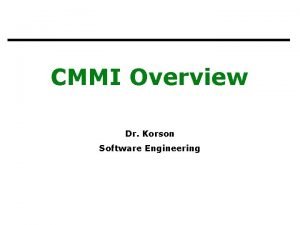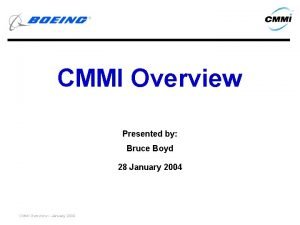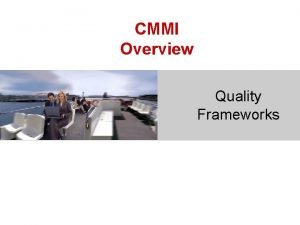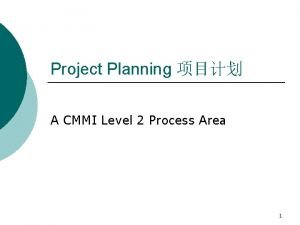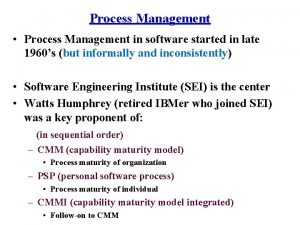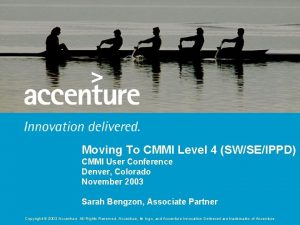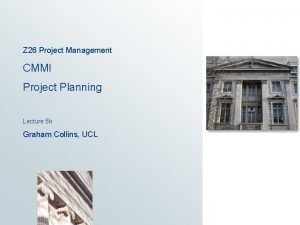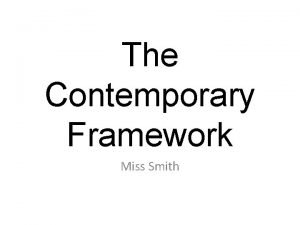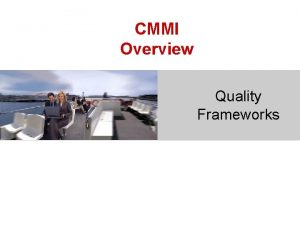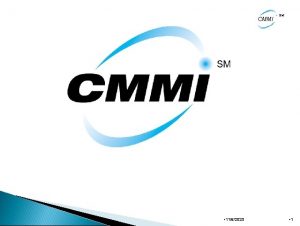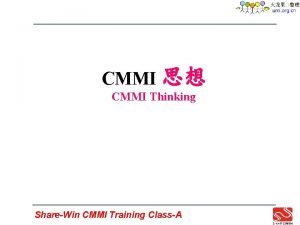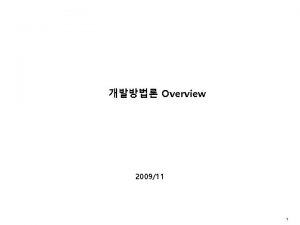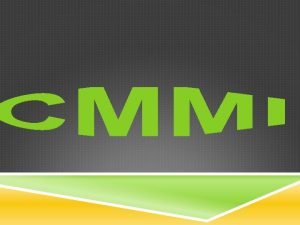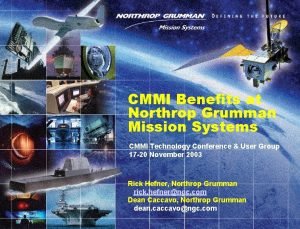CMMI Overview Quality Frameworks Outline Introduction High level















- Slides: 15

CMMI Overview Quality Frameworks

Outline • Introduction • High level overview of CMMI • Questions and comments Slide 2 of 146

What is CMMI? • CMMI (Capability Maturity Model Integration) is a proven industry framework to improve product quality and development efficiency for both hardware and software – Sponsored by US Department of Defence in cooperation with Carnegie Mellon University and the Software Engineering Institute (SEI) – Many companies have been involved in CMMI definition such as Motorola and Ericsson – CMMI has been established as a model to improve business results • CMMI, staged, uses 5 levels to describe the maturity of the organization, same as predecessor CMM – Vastly improved version of the CMM – Emphasis on business needs, integration and institutionalization Slide 3 of 146

CMMI Models within the Framework • Models: – Systems Engineering + Software Engineering (SE/SW) – Systems Engineering + Software Engineering + Integrated Product and Process Development (IPPD) – Systems Engineering + Software Engineering + Integrated Product and Process Development + Supplier Sourcing (SS) – Software Engineering only • Representation options: – Staged – Continuous • The CMMI definition of “Systems Engineering” “The interdisciplinary approach governing the total technical and managerial effort required to transform a set of customer needs, expectations and constraints into a product solution and to support that solution throughout the product’s life. ” This includes both hardware and software. Slide 4 of 146

CMMI Staged Representation - 5 Maturity Levels Level 5 Optimizing ce s s. M at ur it y Level 4 Quantitatively Managed Pr o Level 3 Defined Level 2 Managed Level 1 Initial Slide 5 of 146 Process performance continually improved through incremental and innovative technological improvements. Processes are controlled using statistical and other quantitative techniques. Processes are well characterized and understood. Processes, standards, procedures, tools, etc. are defined at the organizational (Organization X ) level. Proactive. Processes are planned, documented, performed, monitored, and controlled at the project level. Often reactive. Processes are unpredictable, poorly controlled, reactive.

Maturity Level 1 Initial • Maturity Level 1 deals with performed processes. • Processes are unpredictable, poorly controlled, reactive. • The process performance may not be stable and may not meet specific objectives such as quality, cost, and schedule, but useful work can be done. Slide 6 of 146

Maturity Level 2 Managed at the Project Level • Maturity Level 2 deals with managed processes. • A managed process is a performed process that is also: – – – Planned and executed in accordance with policy Employs skilled people Adequate resources are available Controlled outputs are produced Stakeholders are involved The process is reviewed and evaluated for adherence to requirements • Processes are planned, documented, performed, monitored, and controlled at the project level. Often reactive. • The managed process comes closer to achieving the specific objectives such as quality, cost, and schedule. Slide 7 of 146

Maturity Level 3 Defined at the Organization Level • Maturity Level 3 deals with defined processes. • A defined process is a managed process that: – Well defined, understood, deployed and executed across the entire organization. Proactive. – Processes, standards, procedures, tools, etc. are defined at the organizational (Organization X ) level. Project or local tailoring is allowed, however it must be based on the organization’s set of standard processes and defined per the organization’s tailoring guidelines. • Major portions of the organization cannot “opt out. ” Slide 8 of 146

Behaviors at the Five Levels Maturity Level Optimizing Process Characteristics Behaviors Focus on "fire prevention"; Focus is on continuous improvement anticipated and quantitative improvement desired, and impacts assessed. Quantitatively Process is measured and controlled Managed Greater sense of teamwork and interdependencies Defined Process is characterized for the organization and is proactive Reliance on defined process. People understand, support and follow the process. Managed Process is characterized for projects and is often reactive Over reliance on experience of good people – when they go, the process goes. “Heroics. ” Initial Slide 9 of 146 Process is unpredictable, Focus on "fire fighting"; effectiveness low – frustration high. poorly controlled, and reactive

CMMI Components • Within each of the 5 Maturity Levels, there are basic functions that need to be performed – these are called Process Areas (PAs). • For Maturity Level 2 there are 7 Process Areas that must be completely satisfied. • For Maturity Level 3 there are 11 Process Areas that must be completely satisfied. • Given the interactions and overlap, it becomes more efficient to work the Maturity Level 2 and 3 issues concurrently. • Within each PA there are Goals to be achieved and within each Goal there are Practices, work products, etc. to be followed that will support each of the Goals. Slide 10 of 146

CMMI Process Areas Slide 11 of 146

CMMI Terminology & Structure Maturity Levels (1 - 5) Process Area 1 Required. Specific for each process area. Process Area 2 Specific Goals Process Area n Generic Goals Common Commitment to Perform Inf orm ati v Specific Practices Required e Sub practices, typical work products, discipline amplifications, generic practice elaborations, goal and practice titles, goal and practice notes, and references Slide 12 of 146 Ability to Perform Required. Common across all process areas. Features Directing Implementation Generic Practices Verifying Implementation rm o f In v ati Sub practices, typical work products, discipline amplifications, generic practice elaborations, goal and practice titles, goal and practice notes, and references e

Example For the Requirements Management Process Area: An example Goal (required): “Manage Requirements” An example Practice to support the Goal (required): “Maintain bi-directional traceability of requirements” Examples (suggested, but not required) of typical Work Products might be Requirements traceability matrix or Requirements tracking system Slide 13 of 146

Yet another CMMI term: Institutionalization • This is the most difficult part of CMMI implementation and the portion where managers play the biggest role and have the biggest impact • Building and reinforcement of corporate culture that supports methods, practices and procedures so they are the ongoing way of business……. . – Must be able to demonstrate institutionalization of all CMMI process areas for all organizations, technologies, etc. • Required for all Process Areas Slide 14 of 146

CMMI Resources • Software Engineering Institute's CMMI website: http: //www. sei. cmu. edu/cmmi/ Slide 15 of 146
 Dr korson
Dr korson Cmmi overview
Cmmi overview Accent and dialect english language a level revision
Accent and dialect english language a level revision High level outline
High level outline Cmmi level 2 requirements
Cmmi level 2 requirements Scm is a cmmi level process area
Scm is a cmmi level process area Cmmi level 4 stands for
Cmmi level 4 stands for Cmmi requirements management
Cmmi requirements management Capability maturity model
Capability maturity model Low-level thinking in high-level shading languages
Low-level thinking in high-level shading languages Data cleaning problems and current approaches
Data cleaning problems and current approaches Data quality and data cleaning an overview
Data quality and data cleaning an overview Data quality and data cleaning an overview
Data quality and data cleaning an overview Arnoldo hax
Arnoldo hax Restatement sentence examples
Restatement sentence examples Contemporary framework art
Contemporary framework art
